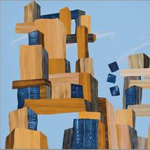Petraphilia: The Love of Stones is an exhibition in which viewing stones are displayed together with contemporary works of art inspired by the artists’ interest in Chinese scholar’s rocks, stones, boulders and the landscape. Exhibiting artists include Hilary Baker, Keiko Fukazawa, Lia Halloran, Jacci Den Hartog, Shoshi Kanokohata, Noel Korten, Pierre Picot and Richard Turner. Viewing stones on display are from the collections of Tom Elias, James Greaves and Freeman Wang. The exhibition is curated by Richard Turner. An opening night reception will be held Saturday January 17 from 6-9pm.
All cultures have held certain stones in high regard. In China, however, a tradition of stone collecting and connoisseurship evolved that was unrivaled. Viewing stones were appreciated for their formal properties and for their ability to evoke distant landscapes, human and animal forms, deities and the physical and spiritual energies of the universe. Scholars’ rocks were collected and displayed as far back as the 10th century Song Dynasty in China. The tradition was introduced into Japan and by the 14th century a distinctly Japanese version, suiseki, was flourishing. The American viewing stone practice, which is barely a half-century old, derives from both the Japanese and Chinese traditions as they have been understood and interpreted by American practitioners.
Since the 1996 Metropolitan Museum of Art exhibition Worlds Within Worlds: The Richard Rosenblum Collection of Chinese Scholars’ Rocks introduced western artists to viewing stones, artists as diverse as Roy Lichtenstein and Ugo Rondinone, Zhan Wang and Arlene Shechet, Brice Marden and Andrea Cohen have been working with ideas inspired by their encounters with viewing stones. However, there have been very few exhibitions of such work displayed alongside the stones themselves. Petraphilia: The Love of Stones will be a first for Los Angeles.
ARTISTS:
Viewing Stone Collectors
For Thomas Elias the diversity of his collection is the key to understanding contemporary viewing stone practices and keeping abreast of the latest developments around the globe. The stones he displays in this exhibition reflect the broad range of his interests. James Greaves repurposes a traditional piece of Japanese display furniture and employs it to present a grouping of stones that evoke memories of the archeological digs in Greece and Turkey where he worked on summers abroad and the Turkish ceramics that he collected at an earlier time in his life. Freeman Wang grew up around stones. He was born in the city of Luzhou which is sometimes referred to as the stone capitol of China. He chooses stones for himself, and encourages his clients to select stones, based on whether or not the stone “talks to you”.
FOCA’s exhibition space is located at 970 North Broadway Suite 208, Los Angeles CA. Hours are Tuesday – Friday 10:00AM to 5:00PM. For further information please contact Jackie Navarrete, foca@focla.org, FOCA Office Administrator (213) 808-1008.
EVENTS:
Opening night reception will be held Saturday January 17, 2015 from 6-9pm

